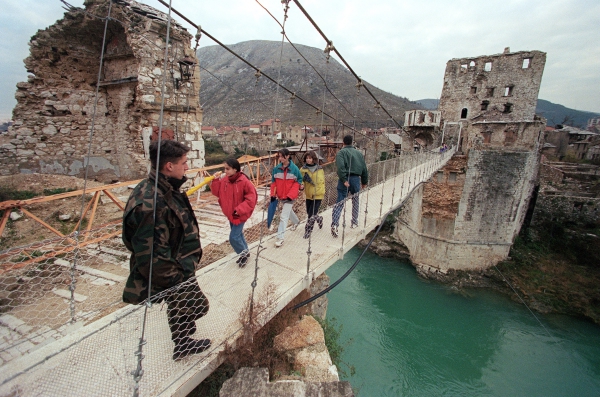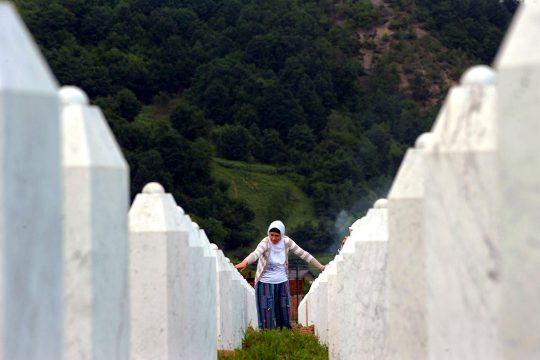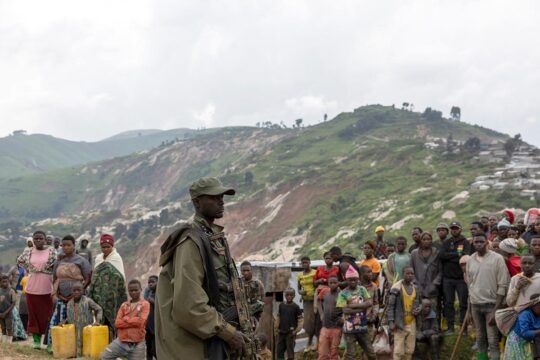To what extent does the destruction of an architectural masterpiece constitute a war crime if that masterpiece is also used for military purposes? What, too, if the destruction of such a monument, like the Old Mostar Bridge, causes psychological and physical harm to a civilian population now under siege? How should military objectives, damage to cultural heritage, psychological and physical harm be weighed together? That was the headache posed by the last judgment of the International Criminal Tribunal for the former Yugoslavia (ICTY).
The ICTY’s last judgment on November 29 will be remembered for the televised live suicide of Slobodan Praljak, one of the six accused, as the sentence was being read out. But another aspect of this judgement, which also concerns Slobodan Praljak directly, caused deep divisions between the ICTY judges of the Trial Chamber and the Appeals Chamber in their analysis. Do the 50 or so shells that fell on the Old Mostar Bridge (Stari Most in Serbo-Croat) constitute a war crime if this destruction is linked to acts of persecution? Let us remember that the Old Bridge dates from the 16th century, is a jewel of Ottoman architecture and even a symbol of multiculturalism in the Balkans.
The ICTY’s judgment on the destruction of the Old Mostar Bridge has special importance at a time when the Taliban destruction of the Bamiyan Buddhas and the destruction by Salafist groups of cultural heritage in Iraq, Syria and Mali have given cultural crimes a new resonance. It also comes after the International Criminal Court (ICC) in 2016 sentenced Ahmad Al-Faqi Al-Mahdi, destroyer of the Timbuktu mausoleums, to nine years in jail for a war crime.
The destruction of cultural heritage was also a determining factor in former Yugoslavia’s wars in the 1990s, when hundreds of mosques and churches were deliberately destroyed. Cultural cleansing often went alongside ethnic cleansing, seeking to wipe out the links that unite communities around their culture. More than fifteen ICTY judgments sanction the destroyers of cultural heritage, such as those who ordered bombing causing the fire that destroyed the Sarajevo library, burning 90% of the manuscripts, or the old town of Dubrovnik.
Legitimate military target?
However, the destruction of the Old Mostar Bridge during the 1993 war is a special case. The war at the time pitted the HVO Croat forces against Bosnian (ABiH) soldiers in the town of Mostar. The bridge allowed the latter to bring arms supplies and to bring food and medicines to besieged Muslim civilians on the west bank.
So was the Old Bridge therefore a legitimate military target for the HVO forces? The ICTY Trial Chamber considered in 2013 that it was. In its judgment, it states that the Old Bridge was indeed a military target, but added that its destruction was disproportionate to the military gains achieved. It was therefore an illegal act, a war crime and a crime against humanity, being “an underlying act of persecutions on political, racial and religious grounds as a crime against humanity and unlawful infliction of terror on civilians as a violation of the laws and customs of war “). The 2013 judgment (para. 1294-1366) takes the different elements into account in reaching this conclusion. It points to the historic and symbolic value of the bridge, recognizing at the same time that “the Old Bridge was essential to the ABiH for the combat activities of its units on the front line, for evacuations and for sending troops, provisions and material and that it was used for this purpose”. But the Trial Chamber also recognized that the Old Bridge was also “essential for supplies to the inhabitants of the Muslim enclave on the right bank of the Neretva” river.
In this long judgement of some 2,000 pages covering a spectrum of crimes committed by the six accused, 80 paragraphs (!) are dedicated to the destruction of the Old Mostar Bridge. But we do not know how the judges determined the disproportionate and therefore illegal nature of the HVO’s bombing of the bridge. How did the Trial Chamber judges weigh the elements of psychological and physical damage, cultural heritage and military target? The criterion of proportionality is based on the idea that the military gains achieved must be concrete and direct. Was that not the case? Or was the cultural, psychological and physical harm caused to the besieged populations too serious in comparison with the direct, concrete advantages obtained? Nobody knows, but the 2013 judgment concludes that this was a war crime and a crime against humanity, because the destruction of the Old Bridge was accompanied by a “will to terrorize” the civilians who were now completely under siege.
The Appeals Court, in its 29 November 2017 judgment, threw out this conclusion of the 2013 decision, deeming that because the bridge was a military target its destruction was legal, producing “a definite military advantage”. As a consequence, the Court said, its destruction could not be considered “wanton destruction not justified by military necessity”. This point of view was vigorously contested in a dissenting opinion by Judge Fausto Pocar. He expressed surprise that his colleagues on the Appeals Court had ignored the 1954 Convention on the protection of cultural property, which stipulates in Article 4, paragraph 2 that there can only be a waiver for destruction of cultural heritage “in cases where military necessity imperatively requires such a waiver”, with military necessity being defined by the absence of alternative to the destruction.
These divergences of analysis between the ICTY judges reflect the current state of debate on the laws of war. How should psychological harm, which the 2013 judgment points to, be measured? Should it even be taken into account? Isn’t weakening the morale of the enemy an intrinsic part of war? How can a commander in the thick of battle determine the long-term psychological damage he is inflicting? And how should the cultural value of an object be added to psychological harm and weighed against the proportionality criterion of international humanitarian law? These questions reflect a wider one: how far should the definition of war crimes, crimes against humanity and acts of genocide be taken? Since the birth of the ICTY in 1993, these definitions have continued to expand, with a potential longer term risk of undermining the whole judicial edifice. If every crime becomes a potential international crime, then there is the risk that international crimes will become diluted, commonplace and finally lose the power to call to account. This is perhaps what the majority of judges wanted to counterbalance in this last judgment of the ICTY before it closes its doors.







